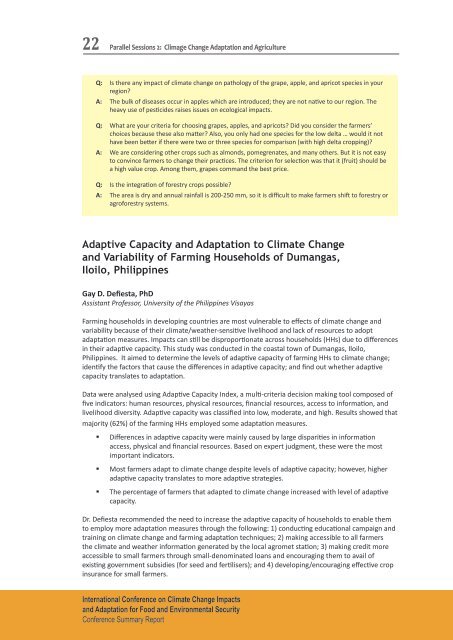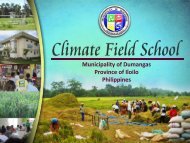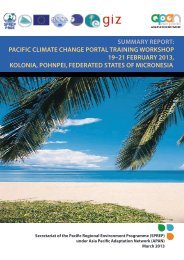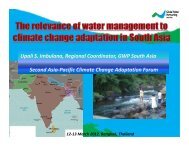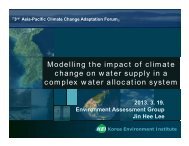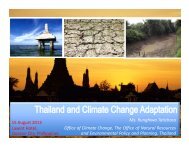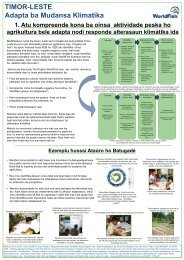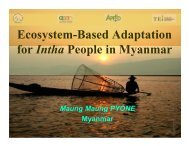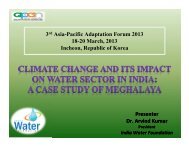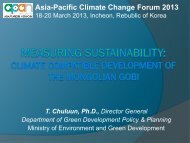PDF file (2.44 MB) - Asia Pacific Adaptation Network
PDF file (2.44 MB) - Asia Pacific Adaptation Network
PDF file (2.44 MB) - Asia Pacific Adaptation Network
You also want an ePaper? Increase the reach of your titles
YUMPU automatically turns print PDFs into web optimized ePapers that Google loves.
22Parallel Sessions 2: Climage Change <strong>Adaptation</strong> and AgricultureQ: Is there any impact of climate change on pathology of the grape, apple, and apricot species in yourregion?A: The bulk of diseases occur in apples which are introduced; they are not native to our region. Theheavy use of pesticides raises issues on ecological impacts.Q: What are your criteria for choosing grapes, apples, and apricots? Did you consider the farmers’choices because these also matter? Also, you only had one species for the low delta … would it nothave been better if there were two or three species for comparison (with high delta cropping)?A: We are considering other crops such as almonds, pomegrenates, and many others. But it is not easyto convince farmers to change their practices. The criterion for selection was that it (fruit) should bea high value crop. Among them, grapes command the best price.Q: Is the integration of forestry crops possible?A: The area is dry and annual rainfall is 200-250 mm, so it is difficult to make farmers shift to forestry oragroforestry systems.Adaptive Capacity and <strong>Adaptation</strong> to Climate Changeand Variability of Farming Households of Dumangas,Iloilo, PhilippinesGay D. Defiesta, PhDAssistant Professor, University of the Philippines VisayasFarming households in developing countries are most vulnerable to effects of climate change andvariability because of their climate/weather-sensitive livelihood and lack of resources to adoptadaptation measures. Impacts can still be disproportionate across households (HHs) due to differencesin their adaptive capacity. This study was conducted in the coastal town of Dumangas, Iloilo,Philippines. It aimed to determine the levels of adaptive capacity of farming HHs to climate change;identify the factors that cause the differences in adaptive capacity; and find out whether adaptivecapacity translates to adaptation.Data were analysed using Adaptive Capacity Index, a multi-criteria decision making tool composed offive indicators: human resources, physical resources, financial resources, access to information, andlivelihood diversity. Adaptive capacity was classified into low, moderate, and high. Results showed thatmajority (62%) of the farming HHs employed some adaptation measures.• Differences in adaptive capacity were mainly caused by large disparities in informationaccess, physical and financial resources. Based on expert judgment, these were the mostimportant indicators.• Most farmers adapt to climate change despite levels of adaptive capacity; however, higheradaptive capacity translates to more adaptive strategies.• The percentage of farmers that adapted to climate change increased with level of adaptivecapacity.Dr. Defiesta recommended the need to increase the adaptive capacity of households to enable themto employ more adaptation measures through the following: 1) conducting educational campaign andtraining on climate change and farming adaptation techniques; 2) making accessible to all farmersthe climate and weather information generated by the local agromet station; 3) making credit moreaccessible to small farmers through small-denominated loans and encouraging them to avail ofexisting government subsidies (for seed and fertilisers); and 4) developing/encouraging effective cropinsurance for small farmers.International Conference on Climate Change Impactsand <strong>Adaptation</strong> for Food and Environmental SecurityConference Summary Report


